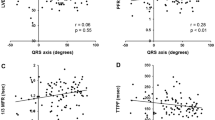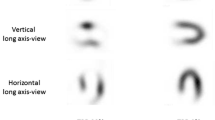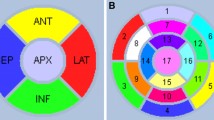Abstract
The frontal QRS-T angle is one of the markers of ventricular repolarization. We sought to assess the effects of myocardial perfusion defect on QRS-T angle in patients with prior anterior myocardial infarction (MI). Seventy-one patients with prior anterior MI and 71 age- and sex-matched control subjects having no myocardial perfusion defect were selected. Frontal QRS-T angle was defined as the absolute value of the difference between the frontal plane QRS axis and T-wave axis. The extent of myocardial perfusion defect was determined using myocardial perfusion single-photon emission computed tomography (SPECT). The extent of myocardial perfusion defect of patients with prior anterior MI was 21.8 ± 13.7%. Frontal QRS-T angle was significantly larger in patients with prior anterior MI than control subjects (82° ± 49° vs 30° ± 26°, p < 0.001). Prevalence of abnormal frontal QRS-T angle defined as more than 90° was significantly higher in patients with prior anterior MI than control subjects (42% vs 4%, p < 0.001). Multivariate linear regression analysis showed that age (β=0.18, p = 0.02) and myocardial perfusion defect (β = 0.46, p = 0.02) were independent determinants of frontal QRS-T angle. Our results suggest that the extent of myocardial perfusion defect is an independent determinant of frontal QRS-T angle in patients with prior anterior MI.


Similar content being viewed by others
References
Oehler A, Feldman T, Henrikson CA, Tereshchenko LG (2014) QRS-T angle: a review. Ann Noninvasive Electrocardiol 19:534–542
Aro AL, Huikuri HV, Tikkanen JT, Junttila MJ, Rissanen HA, Reunanen A, Anttonen O (2012) QRS-T angle as a predictor of sudden cardiac death in a middle-aged general population. Europace 14:872–876
May O, Graversen CB, Johansen MØ, Arildsen H (2017) A large frontal QRS-T angle is a strong predictor of the long-term risk of myocardial infarction and all-cause mortality in the diabetic population. J Diabetes Complicat 31:551–555
Gotsman I, Keren A, Hellman Y, Banker J, Lotan C, Zwas DR (2013) Usefulness of electrocardiographic frontal QRS-T angle to predict increased morbidity and mortality in patients with chronic heart failure. Am J Cardiol 111:1452–1459
Lown MT, Munyombwe T, Harrison W, West RM, Hall CA, Morrell C, Jackson BM, Sapsford RJ, Kilcullen N, Pepper CB, Batin PD, Hall AS, Gale CP, Evaluation of Methods and Management of Acute Coronary Events (EMMACE) Investigators (2012) Association of frontal QRS-T angle-age risk score on admission electrocardiogram with mortality in patients admitted with an acute coronary syndrome. Am J Cardiol 109:307–313
Germano G, Kavanagh PB, Slomka PJ, Van Kriekinge SD, Pollard G, Berman DS (2007) Quantitation in gated perfusion SPECT imaging: the Cedars-Sinai approach. J Nucl Cardiol 14:433–454
Kurisu S, Shimonaga T, Ikenaga H, Watanabe N, Higaki T, Ishibashi K, Dohi Y, Fukuda Y, Kihara Y (2017) Selvester QRS score and total perfusion deficit calculated by quantitative gated single-photon emission computed tomography in patients with prior anterior myocardial infarction in the coronary intervention era. Heart Vessels 32:369–375
Kurisu S, Nitta K, Sumimoto Y, Ikenaga H, Ishibashi K, Fukuda Y, Kihara Y (2018) Effects of aortic tortuosity on left ventricular diastolic parameters derived from gated myocardial perfusion single photon emission computed tomography in patients with normal myocardial perfusion. Heart Vessels 33:651–656
Pavri BB, Hillis MB, Subacius H, Brumberg GE, Schaechter A, Levine JH, Kadish A, Defibrillators in Nonischemic Cardiomyopathy Treatment Evaluation (DEFINITE) Investigators (2008) Prognostic value and temporal behavior of the planar QRS-T angle in patients with nonischemic cardiomyopathy. Circulation 117:3181–3186
Padala SK, Ghatak A, Padala S, Katten DM, Polk DM, Heller GV (2014) Cardiovascular risk stratification in diabetic patients following stress single-photon emission-computed tomography myocardial perfusion imaging: the impact of achieved exercise level. J Nucl Cardiol 21:1132–1143
Kasama S, Toyama T, Sato M, Sano H, Ueda T, Sasaki T, Nakahara T, Higuchi T, Tsushima Y, Kurabayashi M (2016) Prognostic value of myocardial perfusion single photon emission computed tomography for major adverse cardiac cerebrovascular and renal events in patients with chronic kidney disease: results from first year of follow-up of the Gunma-CKD SPECT multicenter study. Eur J Nucl Med Mol Imaging 43:302–311
Huikuri HV, Castellanos A, Myerburg RJ (2001) Sudden death due to cardiac arrhythmias. N Engl J Med 345:1473–1482
Zeidan-Shwiri T, Yang Y, Lashevsky I, Kadmon E, Kagal D, Dick A, Laish Farkash A, Paul G, Gao D, Shurrab M, Newman D, Wright G, Crystal E (2015) Magnetic resonance estimates of the extent and heterogeneity of scar tissue in ICD patients with ischemic cardiomyopathy predict ventricular arrhythmia. Heart Rhythm 12:802–808
Scott PA, Rosengarten JA, Murday DC, Peebles CR, Harden SP, Curzen NP, Morgan JM (2013) Left ventricular scar burden specifies the potential for ventricular arrhythmogenesis: an LGE-CMR study. J Cardiovasc Electrophysiol 24:430–436
He YM, Yang XJ, Wu YW, Zhang B (2009) Twenty-four-hour thallium-201 imaging enhances the detection of myocardial ischemia and viability after myocardial infarction: a comparison study with echocardiography follow-up. Clin Nucl Med 34:65–69
Author information
Authors and Affiliations
Corresponding author
Ethics declarations
Conflict of interest
The authors declare that they have no conflict of interest.
Additional information
Publisher's Note
Springer Nature remains neutral with regard to jurisdictional claims in published maps and institutional affiliations.
Rights and permissions
About this article
Cite this article
Kurisu, S., Nitta, K., Sumimoto, Y. et al. Myocardial perfusion defect assessed by single-photon emission computed tomography and frontal QRS-T angle in patients with prior anterior myocardial infarction. Heart Vessels 34, 971–975 (2019). https://doi.org/10.1007/s00380-018-01330-9
Received:
Accepted:
Published:
Issue Date:
DOI: https://doi.org/10.1007/s00380-018-01330-9




